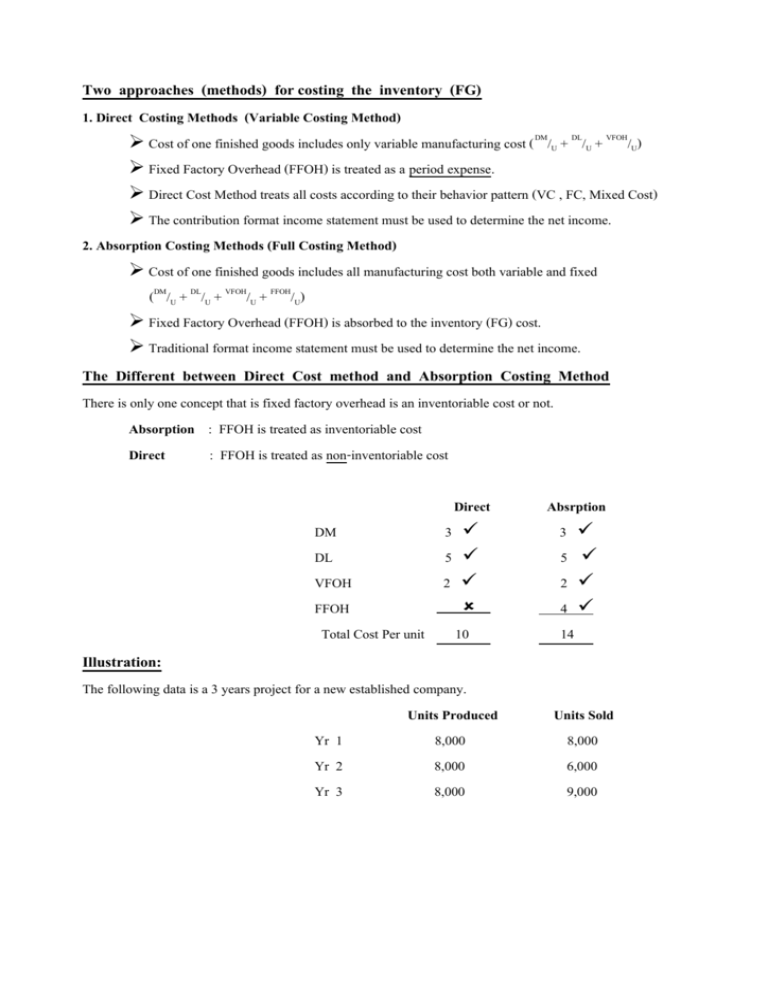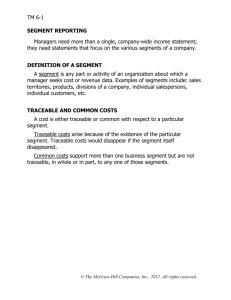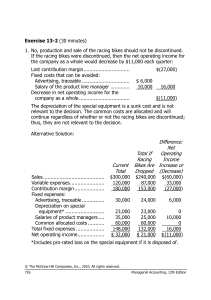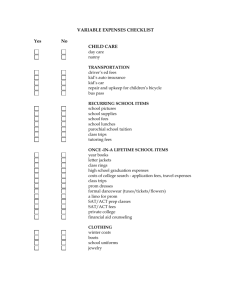Two approaches (methods) for costing the inventory (FG) The
advertisement

Two approaches (methods) for costing the inventory (FG)
1. Direct Costing Methods (Variable Costing Method)
Cost of one finished goods includes only variable manufacturing cost ( DM/U + DL/U + VFOH/U)
Fixed Factory Overhead (FFOH) is treated as a period expense.
Direct Cost Method treats all costs according to their behavior pattern (VC , FC, Mixed Cost)
The contribution format income statement must be used to determine the net income.
2. Absorption Costing Methods (Full Costing Method)
Cost of one finished goods includes all manufacturing cost both variable and fixed
(DM/U + DL/U + VFOH/U + FFOH/U)
Fixed Factory Overhead (FFOH) is absorbed to the inventory (FG) cost.
Traditional format income statement must be used to determine the net income.
The Different between Direct Cost method and Absorption Costing Method
There is only one concept that is fixed factory overhead is an inventoriable cost or not.
Absorption : FFOH is treated as inventoriable cost
Direct
: FFOH is treated as non-inventoriable cost
Direct
DM
3
DL
5
VFOH
2
FFOH
Total Cost Per unit 10
Absrption
3
5
2
4
14
Illustration:
The following data is a 3 years project for a new established company.
Units Produced
Yr 1
8,000
Yr 2
8,000
Yr 3
8,000
Units Sold
8,000
6,000
9,000
The revenue and cost structures are as follows:
Selling Price
50 $/U
Variable Costs:
Direct material
10 $/U
Direct labor
15 $/U
Variable overhead
3 $/U
Variable selling
2 $/U
Total Variable Cost
30 $/U
Fixed Costs:
Factory overhead
40,000 $/yr
Selling
25,000 $/yr
Total Fixed Cost
65,000 $/yr
Required : Prepare projects income statement for each year under absorption and direct costing method
Income statement ( Absorption ) Y1
Y1
Sale (8,000 x 50)
$ 400,000
Less Cost of good sold:
BB FG
(0)
Add CGM (8000 x 33) 264,000
Cost of good available for sale 264,000
Less EB FG (0 x 33)
(0) (264,000)
Gross Profit
136,000
Less Operating Expense:
#(24,000)
Variable S&A Exp. (8000 x 2) 16,000
160,000
Fixed S&A Exp
25,000 (41,000)
Net Income
95,000
Reconcile
(65,000)
Up = US
95,000
Ab = Di
Income statement (Direct)
Sale (8,000 x 50)
Less Total Variable Cost:
BB FG
$ 400,000
Add CGM (8000 x 28) 224,000
Cost of good available for sale 224,000
Less EB FG
(0)
Variable CGS
224,000
Add Variable S7A Exp. (8,000x2) 16,000
Contribution Margin
Less Total Fixed Cost:
Fixed FOH
Fixed S&A Exp
Net Income
40,000
25,000
Income Statement (Absorption)
Y1
$ 300,000
Sale (6000 x 50)
Less Cost of good sold:
BB FG
(0)
Add CGM
264,000
Cost of goods available for sale
264,000
Less EB FG (2000 x 33)
( 66,000 )
198,000
Gross Profit
102,000
Less Operating Expense:
Variable S&A Exp. ( 6000 x 2 )
12000
Fixed S&A Exp.
25,000
( 37,000 )
Net Income
65,000
…………………………………………………………………………………………
Reconcile
Up > Us
[ FFOH x US ] - FFOH
Up
Ab > Di
65,000 55,000 [ 40000 x 6000] - 40000 = ( - 10000 )
A = 10,000
8000
Income Statement (Direct)
y2
Sale
( 6000 x 50 )
$ 300,000
Less Cost of good sold:
BB FG
(0)
Add CGM
( 8000 x 28 )
224,000
Cost of goods available for sale
224,000
Less EB FG ( 2000 x 28 )
( 56,000 )
Variable CGS
168,000
Add Variable S&A Exp. ( 6000 x 2 ) 12000 180,000
Contribution Margin
120,000
Less Total Fixed Cost:
Fixed FOH
40000
FIXED S&A Exp
25,000
( 65000 )
Net Income
55,000
Income Statement (Absorption)
y3
Sale
( 9000 x 50 )
$ 450,000
Less Cost of good sold:
BB FG ( 2000 x 33 )
66,000
Add CGM
( 8000 x 33 )
264,000
Cost of goods available for sale
330,000
Less EB FG ( 1000 x 33 )
( 33,000 ) ( 297,000 )
Gross Profit
153,000
Less Operating Expense:
Variable S&A Exp. ( 9000 x 2 )
18000
Fixed S&A Exp.
25000 ( 43,000 )
Net Income
110,000
.........................................................................................................................................
Reconcile
Up
<
Us
Ab < Di
11,000 < 115,000
= 5000
FFOH x US - FFOH + ( AFFOH/u
up
40,000 x 9000 - 40,000 + ( ? x 0 ) = 5,000
8000
Direct and Absorption
Problem 1
Year 1
Direct
Year 2
Absorption
DM
DL
6
VFOH
FFOH
Cost/unit
6
FFOH of year 2 = $ 10,000
Selling price = $ 15
Variable selling = $ 500
Fixed selling = $ 1,500
Direct
Absorption
DM
DL
5
VFOH
FFOH
Cost/unit 5
?
BBFG + Up - Us = EBFG
Year 1:
= 400
Year 2: 400 + 2,000 - 2,200 = 200
3
9
Required:
- Prepare the income statements for year 2 under direct and absorption method using FIFO.
- Prepare the income statements for year 2 under direct and absorption method using LIFO.
- Reconcile the net income above.
Problem 2
Year 1
Direct
DM
DL
VFOH
FFOH
Cost/unit
FFOH of year 2
Selling price
Variable selling
Fixed selling
6
= $ 6,000
= $ 15
= $ 500
= $ 1,500
Year 2
Absorption
11
Direct
Absorption
DM
DL
VFOH
FFOH
Cost/unit 7
BBFG + Up
?
- Us
= EBFG
Year 2: 400 + 2,000 - 2,200 = 200
Required:
- Prepare the income statements for year 2 under direct and absorption method using FIFO.
- Prepare the income statements for year 2 under direct and absorption method using LIFO.
- Reconcile the net income above.
Chapter 12 Segment Reporting and Decentralization
Decentralized Organization: An organization in which decision making is not confined to a few top
executives but rather is spread throughout the organization.
Cost center: A business segment whose manager has control over cost but has no control over revenue or
the use of investment funds.
Profit Center: A business segment whose manager has control over cost and revenue but has no control
over the use of investment funds.
Investment Center: A business segment whose manager has control over cost, revenue, and the use of
investment funds.
Responsibility Center: Any business segment whose manager has control over cost, revenue, or the use of
investment funds.
Segment: Any part or activity of an organization about which the manager seeks cost, revenue or profit.
Segment Margin: The amount computed by deducting the traceable fixed costs of a segment from the
segment’s contribution margin. It represents the margin available after segment has covered all of its own
traceable costs.
Traceable Fixed Cost:A fixed cost that is incurred because of the existence of a particular business
segment.
Common fixed cost: A fixed cost that supports the operations of more than one segment. Even if a segment
were entirely eliminated, there would be no change in a true common fixed cost.
Sale ………………………….
Less variable expenses………………………….
Contribution margin………………………….
Less traceable fixed expenses………………………….
Segment margin………………………….
Less common fixed expenses………………………….
Net operating income (EBIT) ………………………….
Illustration: The business staff of the legal firm Frampton, Davis and Smythe has constructed the
following report which breaks down the firm’s overall results for the last month in terms of its two main
business segments-family law and commercial law:
Family
Commercial
Total
Law
Law
Revenues from clients
$ 1,000,000
$ 400,000
$ 600,000
Less variable expenses
220,000
100,000
120,000
Contribution margin
780,000
300,000
480,000
Less traceable fixed expenses
670,000
280,000
390,000
Segment margin
110,000
20,000
90,000
Less common fixed expenses
60,000
24,000
36,000
Net operating income
$ 50,000
$ (4,000)
$ 54,000
However, this report is not quite correct. The common fixed expenses such as the managing partner’s salary,
general administrative expenses, and general firm advertising have been allocated to the two segments based
on revenues from clients.
Required:
1. Redo the segment report, eliminating the allocation of common fixed expenses. Show both
Amount and Percent columns for the firm as a whole and for each of the segments. Would the firm be
better off financially if the family law segment were dropped? (Note: Many of the firm’s commercial low
clients also use the firm for their family law requirements such as drawing up wills.)
Total
Family Law
Commercial Law
Dollars Percent Dollars Percent Dollars Percent
Revenues from Clients………. 1,000,000 100 % 400,000 100%
600,000 100%
Less variable expenses………. (200,000) 22 % (100,000) 25% (120,000) 20%
Contribution margin…………
780,000
78% 300,000 75% 480,000 80%
Less traceable fixed expenses.. (670,000) 67% (280,000) 70% (390,000) 65%
Segment margin………………
110,000
11% 20,000 5%
90,000 15%
Less traceable fixed expenses.. (60,000)
6%
Net operating income………...
50,000
5%
2. The firm’s advertising agency has proposed an ad campaign targeted at boosting the revenues
of the family law segment. The ad campaign would cost $20,000 and the advertising agency claims that it
would increase family law revenues by $100,000. The managing partner of Framptom, Davis & Smythe
belives this increase in business could be accommodated without any increase in fixed expenses. What
effect would this ad campaign have on the family law segment margin and on overall net operating income
of the firm?
Return on investment (ROI) : Net operating income divided by average operating assets. It also
equals margin multiplied by turnover.
ROI = Net operating income
Average operating assets
ROI = Margin x Turnover
Margin = Net operating income
Sale
Turnover =
Sale
Average operating assets
Net operating income: Income before interest and income taxes have been deducted. (EBIT)
Operating assets: Cash accounts receivable, inventory, plant and equipment, and all other assets held for
productive use in an organization.
Margin: A measure of management’s ability to control operating expenses in relation to sales.
Turnover: A measure of the sales that are generated for each dollar invested in operating assets.
Residual income: The net operating income that an investment center eams above the required
return on its operating assets.
Residual income = Net operating income – Minimum required return on operating assets
Illustration: The Magnetic Imaging Division of Medical Diagnostics, Inc., has reported the following
results for last year’s operations:
Sales ……………………………………………..………………. $25 million
Net operating income ………………………………………….. 3 million
Average operating assets ……………………………..……….. 10 million
Required:
Compute the margin, turnover, and ROI for the Magnetic Imaging Division.
Top management of Medical Diagnostics, Inc., has set a minimum required rate of return on average
operating assets of 25%. What is the Magnetic Imaging Division’s residual income for the year?
1) Moigin = net opening income
= 3N = 0.12
12%
sale
25M
turnover =
sale
= 25M = 205 Time
Average operating assets
10M
ROI
FOI
=
=
12% x 2.5 = 30%
net operating income
= 3 = 0.3 30%
Average operating assets
10
2) Residvel income = Net opening income – Min required return on opening asset
= 3,000,000 - 25% ( 10,000,000 ) ) = $500,000
Exercises
Problem1
Caltec, Inc, produces and sells recordable CD and DVD packs. Revenue and cost information relating to the
products follow:
Product
CD
DVD
Selling price per pack………………………… $
8.00
$ 25.00
Variable expenses per pack……………………
3.20
17.50
Traceable fixed expenses year…………………
138,000
45,000
Common fixed expenses in the company total $105,000 annually. Last year the company produced and sold
37,500 CD packs and 18,000 DVD packs.
Required : prepare an income statement for the year segmented by product lines. Show both Amount and
Percent columns for the company as a whole and for each of the products. Carry percentage computations
tone decimal place.
Problem 2
Comparative data on three companies in the same industry are given below:
Company
A
B
C
Sales……………………………………..
$4,000,000
$1,500,000
$6,000,000
Net operation income……………………
560,000
210,000
210,000
Average operation assets………………..
2,000,000
3,000,000
3,000,000
Margin…………………………………..
14%
14%
3.5%
Turnover………………………………...
2
.5
2
ROI………………………………………
28%
7%
7%
Required : Fill in the missing information above
Problem3
Marple Associates is a consulting firm that specializes in information systems for construction and
landscaping companies. The firm has two offices – one in Houston and one in Dallas. The firm classifies the
direct costs of consulting jobs as variable costs. A segmented income statement for the company’s most
recent year is given below:
Segment
Total Company
Houston
Dallas
Sales………………………….
$750,000 100.0%
$150,000 100% $600,000 100%
Less variable expenses……….
405,000 54.0
45,000 30
360,000 60
Contribution margin …………
345,000 46.0
105,000 70
240,000 40
Less traceable fixed expenses..
168,000 22.4
78,000 52
90,000 15
Office segment margin……….
177,000 23.6
$27,000 18% $150,000 25%
Less common fixed expenses
not traceable to segments….
120,000 16.0
Net operating income ……..….
$ 57,000 7.6%
Required:
1. By how much would the company’s not operating income increase if Dallas increased its sales
by $75,000 per year? Assume no change in cost behavior patterns.
2. Refer to the original data. Assume that sales in Houston increase by $50,000 next year and that
sales in Dallas remain unchanged. Assume no change in fixed costs.
a) Prepare a new segmented income statement for the company using the format above.
Show both amounts and percentages.
b) Observe from the income statement you have prepared that the CM ratio for Houston
has remained unchanged at 70% (the same as in the data above) but that the segment margin ratio has
changed. How do you explain the change in the segment margin ratio?
Problem 4
Refer to the data in problem3. Assume that Dallas’s sales by major marker are as follow:
Market
Construction Landscaping
Dallas
Clients
Clients
Sales……………………………………… $600,000 100% $400,000 100% $200,000 100%
Less variable expenses…………………… 360,000 60
260,000 65
100,000 50
Contribution margin……………………… 240,000 40
140,000 35
100,000 50
Less traceable fixed expenses……………
72,000 12
20,000 5
52,000 26
Market segment margin…………………. 168,000 28
$120,000 30% $48,000 24%
Less common fixed expenses
not traceable to market……………..
18,000 3
Office segment margin………………….. $150,000 25%
The company would like to initiate an intensive advertising campaign in one of the two markets during the
next month. The compaign would cost $8,000. Marketing studies indicate that such a campaign would
increase sales in the construction market by $70,000 or increase sales in the landscaping market by
$60,000.
Required:
1. In which of the markets would you recommend that the company focus its advertising
campaign? Show computations to support your answer.
2. In problem3. Dallas shows$90,000 in traceable fixed expenses. What happened to the $90,000 in
this execise?
Relevant Cost for Decision Making (Short-Term Decision Making)
Types of short-term decisions.
1. Special Order (Accept or Reject)
2. Dropping a Product Line (Keep or Drop)
3. Maximizing profit in a multi-product firm
4. Make or Buy
5. Joint Processing
1. Special Order
A decision process that a manager thinks (evaluates) about to accept or reject a special order that is
ordered from a different market at a reduced price.
Note: in this case the company must have an excess productive capacity (Idle capacity)
2. Dropping a Product Line (Keep or Drop)
An analysis showing whether a product line that is always no profitable should be dropped or
retained.
Note: การทำโจทย์เรืWาโจทำโจทย์เรืย์เรื่องนี้เราต[เร]^องนี้เราต้องรู้ด้วยว่า FCc bเราต้องรู้ด้วยว่า FC ตัวไหนสามารeองรfeด้วยว่า FC ตัวไหนสามารถตัดทิ้งได้ (Aeวย์เรื่องนี้เราตวาi FC ต้องรู้ด้วยว่า FC ตัวไหนสามารkวไหนี้เราต้องรู้ด้วยว่า FCสามารถต้องรู้ด้วยว่า FC ตัวไหนสามารkด้วยว่า FC ตัวไหนสามารถตัดทิ้งได้ (Aทำโจทย์เรืqcงได้วยว่า FC ตัวไหนสามารถตัดทิ้งได้ (Ae (Avoidable) และ FC ต้องรู้ด้วยว่า FC ตัวไหนสามารkวไหนี้เราต้องรู้ด้วยว่า FCไมi
สามารถต้องรู้ด้วยว่า FC ตัวไหนสามารkด้วยว่า FC ตัวไหนสามารถตัดทิ้งได้ (Aทำโจทย์เรืcqงได้วยว่า FC ตัวไหนสามารถตัดทิ้งได้ (Ae (Unavoidable)
Avoidable Fixed Cost
- Separate FC
- Traceable FC
- Direct FC
- Discretionary FC
Unavoidable Fixed Cost
- Common FC
- Joint FC
- Indirect FC
- Committed FC
3. Maximizing profit in a multi-product firm
- Occurring in a multi product firm
- Because of a limited production capacity, what the sale mix should be to maximize the company
profit under any constraints.
4. Make or Buy
How to minimize the cost between making or buying.
Make
DM
DL
VFOH
FFOH
Total Cost
Buy
Purchasing Cost
+ Additional exp.
+ Unavoidable FFOH
- Opportunity revenue from idle capacity
Total Cost
5. Joint Processing
A process that is two or more products (outputs) are produced from a single input (common
product).
At split-off point
After split-off
หkวหมf
Pig
เนี้เราต้องรู้ด้วยว่า FCc ]อหมf
กระด้วยว่า FC ตัวไหนสามารถตัดทิ้งได้ (Afก
Joint cost
Processing cost
Joint product
Split-off point
Further Processing
Further Processing
อาหารสkต้องรู้ด้วยว่า FC ตัวไหนสามารว[
cost ใช้ในการแยก common input ออกเป็น Joiใe นี้เราต้องรู้ด้วยว่า FCการแย์เรื่องนี้เราตก common input ออกเป็น Joint products 6횼珬¨耂靄琎le霬琎霔琎雸琎颤ԍ骨ᔾ颤ԍc雔琎隼琎隤琎隐琎xนี้เราต้องรู้ด้วยว่า FC Joint products
cost ทำโจทย์เรืb^เกqด้วยว่า FC ตัวไหนสามารถตัดทิ้งได้ (Aขึ้นในขั้นตอน Further processingerties珬¨靄c zนี้เราต้องรู้ด้วยว่า FCในี้เราต้องรู้ด้วยว่า FCขึ้นในขั้นตอน Further processingerties珬¨靄c kนี้เราต้องรู้ด้วยว่า FCต้องรู้ด้วยว่า FC ตัวไหนสามารอนี้เราต้องรู้ด้วยว่า FC Further processing
outputs ทำโจทย์เรืb^ได้วยว่า FC ตัวไหนสามารถตัดทิ้งได้ (Aeจากการแย์เรื่องนี้เราตก common input
จ{ด้วยว่า FC ตัวไหนสามารถตัดทิ้งได้ (Aทำโจทย์เรืb^เราได้วยว่า FC ตัวไหนสามารถตัดทิ้งได้ (Ae outputs ออกมา
หมfแด้วยว่า FC ตัวไหนสามารถตัดทิ้งได้ (Aด้วยว่า FC ตัวไหนสามารถตัดทิ้งได้ (Aเด้วยว่า FC ตัวไหนสามารถตัดทิ้งได้ (Abย์เรื่องนี้เราตว
3 methods of allocating joint cost
- Relative sales value method (SV)
- Physical volume method (PV)
- Net realizable value method (NRV)
Special Order
Problem 1
Thailand Com Corporation’s capacity is 90,000 minutes of cellular phone receivers, including
15,000 units made on overtime. Thailand Com is currently producing and selling 80,000 units per year at $8
per unit. Variable production cost is $3 per unit, an annual fixed factory overhead costs are $200,000.
Variable selling cost is $0.50 per units; all administrative expenses are $120,000 and fixed. The budgeted
income for the current year is as follows:
Sales (80,000 units @ $8)
$640,000
Production and shipping costs
Variable
$ 284,000
Fixed overhead
200,000
484,000
Administrative expenses
120,000
Total expenses
604,000
Net income
$ 36,000
A communications company from Laos has approached Thailand Com Corporation with the offer
to buy 10,000 receivers at $6 each. Sales to Laos should not affect Thailand Com’s regular sales. The
special units would require minor modifications and force more overtime, adding $0.80 per unit to variable
production cost. Additional supervision would cost $3,000. The entire lot would be packed and shipped to
Laos for $2,000.
Required: Should Thailand Com accept or reject the special order? Explain with supporting computations.
Problem 2
When Products, a market of specialty products, is currently manufacturing and selling a product
called Sticky Goo. X-Mart, a discount department store, has just offered to purchase 60,000 unit of Sticky
Goo at $3.50 per unit for sale in X-Mart stores. The name and packaging for these 60,000 units will be
changed so as not to appear to be the same as Sticky Goo. These changes will not affect the cost of the
product .
Since Wham has enough excess capacity to produce these units, management would like to sell an
additional 60,000. $3.50 is well below their current $9.00 selling price for Sticky Goo. Therefore, Wham
management is concerned about the wisdom of accepting this offer.
Wham Products, $9.00 selling price for Sticky Goo was determined using a 50% markup on
manufacturing costs. Their manufacturing costs per unit of Sticky Goo are:
Direct Material
$
1.00 per unit
Direct Labor
0.60 per unit
Variable Manufacturing Overhead
0.80 per unit
Fixed Manufacturing Overhead
3.60 per unit
Total Manufacturing Cost
$
6.00 per unit
Additional expenses associated with Sticky Goo are variable selling and administrative expenses of
$1.50 per unit and fixed selling and administrative expenses of $0.50 per unit.
No additional fixed manufacturing or selling and administrative expenses will need to be incurred to
permit sale and production of the 60,000 unit special order.
Because these units are being sold directly to the X-Mart store, variable selling and administrative
expenses are expected to be only $0.75 per unit on the special order.
Required: Show all computations
a. Based on the information provided above will Wham’s net income be higher or lower if the
special order?
b. Although the special order units will have a different name and packaging, some of them will be
sold to customers who would normally purchase Sticky Goo. Wham management estimates that 6,000 units
from the special order will be sold to customers who would purchase Sticky-goo. X-Mart has no other
source for the 60,000 units. If they are unable to purchase from Wham, that will not obtain the units. What is
the effect to Wham’s net income if the special order is now accepted?
c. Consider the same additional facts in “part b” except that X-mart will be able to obtain the
60,000 unit somewhere else. How will this effect Wham’s net income if Wham rejects the special order?
Dropping a Product Line (Keep or Drop)
Problem 6
Sunshine Company operates a hardware , Plumbing and Paint. For the past three year, the Paint
Department has shown a net loss, and the owner of the store has asked you to determine whether the Paint
Department should be eliminated. If the owner decides to eliminate the Paint Department 70% of the space
occupied by the department will be used by the Hardware Department and the Plumbing Department. Sales
of the Hardware and Plumbing Departments will not change if the Paint Department is eliminated
1. The owner’s salary $36,000 has been allocated equally among the three departments.
2. At present, there is one sales person and a manger in the Paint Department. If the Paint
Department is eliminated, the manager would be transferred to Hardware Department and salesperson
would be terminated. The salary of the salesperson is $14,000
3. The office expense, telephone expense are allocated on basis of sales. The supplies expense
would decrease by $1,000 if the Paint Department is eliminated, but the office expense and telephone
expense would not change.
4. The rent expense is allocated on the basis of square footage and would not change if the Paint
Department is eliminated.
Make or Buy
Problem 14
The Amplex Radio Company make its own circuit boards for use in the production of its radio line.
One circuit board, FX12, was used in 10,000 radios last year. The cost of producing FX12 were:
Direct material
$
8,000
Direct labor
12,000
Variable overhead
4,000
Fixed overhead
16,000
$
40,000
Amplex is considering purchasing the 10,000 circuit boards Beta Electronics for $2.70 per board
(plus shipping cost of $0.10 per board).
If the board are purchased, the released capacity can be used to produce 500 additional radios,
bringing total production to10,500 radios. The contribution margin per radio is expected to be $10, and the
fixed cost for producing the 10,000 circuit boards are be used to supervise additional production of the
major product line if the board are purchased.
Required: Determine whether the circuit boards should be purchased or produced internally.
Problem 15
Roto. Inc makes steel blades for lawn mowers that it heat treats, assembles, and sells. The cost
accounting system gives the following date
Prime costs
$80,000
Variable manufacturing overhead
60,000
Fixed manufacturing overhead
90,000
Units produced
100,000 units
Roto has an opportunity to purchase its 100,000 blades from and outside supplier at a cost if $2.20
per blade. Inspection of the purchased blades will cost an additional $5,000 in the Quality Assurance
Department. Certain leased equipment, which costs $30,000 and is included in fixed overhead, can be
avoided if the blades are purchased. The released space could be used to make a part that is now purchased,
which would save Roro $46,000
Required :
In quantitative terms should Roto buy the blades from the outside supplier? Explain your
decision.
Maximizing Profit
Problem 20
The Toysuki Company produces two models of television sets. The following information relates to
the production and sale of each model:
Portable
Console
Sales price
$400
$500
Variable cost per unit
$320
$300
Allocated fixed cost
$1,620,000
$3,580,000
Hours needed to produce per unit
2 hr/u
10hr/u
Maximum unit sales
100,000
20,000
The total hours of productive capacity are 250,000. The controller is trying to decide how to
distribute the productive capacity to the two products in order to maximize profits, and she asks for your
advice.
Required:
Determine the number of units of each product that should be produced and sold in order to
maximize profits. What are the maximum possible profits for Toysuki?
Joint Processing
Problem 23
Foodland Company produces meat products with brand names such as Quick, Easy, and Tasty.
Suppose one of the company’s plants processes beef cattle into various products. Assume that there are only
three products : steak, hamburger , and hides ,and that the average steer costs $500. The three products
emerge from a process that costs $76 per cow to run, and output from one cow can be sold for the following
net amounts:
Steak (100 pounds)
$
300
Hamburger (500 pounds)
500
Hides (120 pounds)
$
100
Total
$
900
Assume that each of these three products can be sold immediately or processed further in another
Foodland factory. The steak can be the main course in frozen dinners sold under the Healthy label. The costs
(vegetables, desserts, production, sales, and other costs) to make 400 meals from the 100 pounds of steak
totals $470. Each meal would be sold for $1.90.
The hamburger could be made into frozen patties sold under the Tasty label. The only additional
cost would be a $200 processing cost for the 500 pounds of hamburger. Frozen patties sell for $1.50 per
pound.
The hides can be sold before or after tanning. The cost of tanning one hide is $80, and a tanned hide
can be sold for $175.
The company’s policy is to apportion the joint costs on a method based on units produced.
Required:
1. Prepare a profit statement showing the profit/loss for each product and in total if all three products are
sold after the split-off point.
2. Which products should be sold at the split-off point? Which should be processed further? Also
computer the total profit that can be obtained from the decision taken.
CASH FLOW
Problem 1
The following comparative statement of financial position, statement of comprehensive income,
and addition are available for the Little Bit Incorporation.
Little Bit Incorporation
Statement of Financial Position
December 31, 2009 and 2010
Assets:
2010
2009
Cash
12,000
7,000
Accounts receivable
196,800
129,300
Allowance for uncollectibles
(6,800)
(4,300)
Inventory
280,000
210,000
Prepaid rent
25,000
18,000
Total current assets
507,000
360,000
Plant and Equipment
500,000
450,000
Accumulated depreciation
(105,000)
(95,000)
Land
165,000
150,000
Total non-current assets
560,000
505,000
Total assets
1,067,000
865,000
Liabilities and Equity :
Accounts payable
175,000
150,000
Note payable
Accrued salary payable
Total current liabilities
Bond payable
Mortgage payable
Total long-term liabilities
Total liabilities
Common stock ($1 par)
Additional paid in capital
Retained earnings
Total Equities
Total liabilities and equity
179,000
43,000
397,000
210,000
105,000
315,000
712,000
110,000
70,000
175,000
355,000
1,067,000
Little Bit Incorporation
Statement of comprehensive Income
For the Year Ended December 31, 2010
61,000
52,000
263,000
190,000
95,000
285,000
548,000
100,000
60,000
157,000
317,000
865,000
Sales
950,000
Cost of goods sold expense
650,000
Gross profit
300,000
Operating expenses :
Selling and administrative
100,000
Depreciation
60,000
Other operating
45,000
205,000
Operating income
95,000
Other expense: Gain on sale of building
5,000
Other expense : Interest
40,000
Income before tax
60,000
Income tax expense
20,000
Net income
40,000
Additional information :
1. A building with original cost of $100,000 and accumulated depreciation of $50,000 was sold for $55,000
2. Land was purchased at a cost of $15,000
3. Bonds payable of $20,000 was repaid
4. 10,000 shares of common stock were sold for $2 per share.
5. During 2010, a cash dividend was declared and paid.
Required: Prepare a statement of cash flows for the year 2010 using the indirect method.
Problem 2
The financial statement of Saturn Corporation is presented below. During the company sold
aparcel of land that had a cost of $2,000. It also sold equipment with a book value of $400 and a cost of
$490 for $300 cash.
Saturn Corporation
Comparative Statement of Financial Position
December 31,2002 and 2001
2002
2001
Changes
Assets:
Cash
Accounts receivable (net)
Merchandise inventory
Prepaid expenses
Property plant and equipment
Accumulated depreciation
Total Assets
Liabilities and Equities:
Notes payable
Accounts payable
Dividend payable
Bond payable
Mortgage note payable
Common Stock
Retained earnings
Treasury stock
Total liabilities and equities
Sales
1,586 2,064
3,676 2,980
1,688 1,960
149 138
29,582 26,670
(10,710) (9,870)
$25,971 $23,942
(478)
696
(272)
11
2,912
(840)
2,029
990
919
2,147 2,190
37
28
5,000 3,000
3,000 3,500
8,000 8,000
7,797 6,305
(1,000)
$25,971 $23,942
Saturn corporation
Statement of Comprehensive Income
For the Year Ended December 31, 2002
71
(43)
9
2,000
(500)
0
1,492
(1,000)
2,029
$39,290
Less : Cost of goods sold expense
25,347
Gross profit
13,943
Less : Operation expenses :
Selling and Administrative
5,360
Wage and salaries
4,025
Depreciation
930 10,315
Operating income
3,628
Plus : Gain on sale of land
72
Less : Interest expense
520
Loss on sale of equipment
100 (548)
Income before tax
3,080
Income tax
1,230
Net Income
$1,850
Required : prepare a statement of cash flow of Saturn Corporation for 2002.








